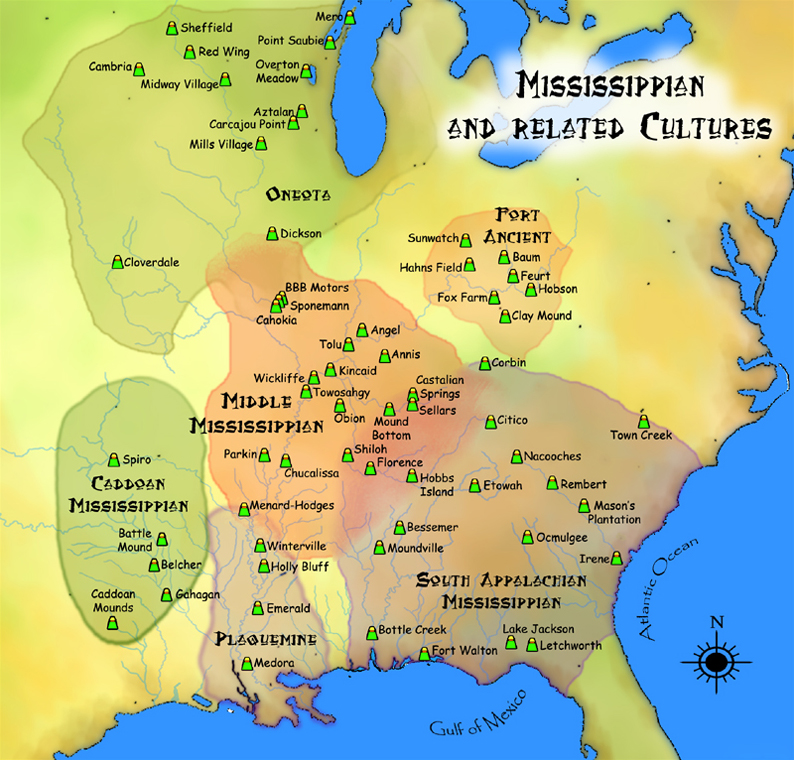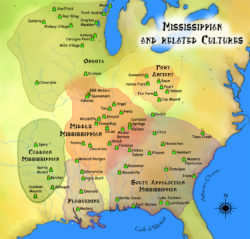Plaquemine Culture
This entry covers the Plaquemine culture in the Lower Mississippi River Valley during the Mississippi period, 1200 to 1700 CE

Courtesy of Wikimedia Commons
Mississippian and Related Cultures. Herb Roe
In the Mississippi period, which spanned 1200–1700 CE, three distinct cultures were visible in Louisiana. Two of these were native to Louisiana: the Caddo culture occupied northwest Louisiana and the Plaquemine culture ranged along the Lower Mississippi River Valley and adjacent coast. Indigenous people associated with these cultures interacted, to a greater or lesser degree, with people distinguished by Mississippian culture, which first arose around 1050 CE in the fertile bottomlands near St. Louis. Mississippian culture had a major influence on many southeastern societies, including those in Louisiana—especially on peoples living in the northeast and extreme southeastern portions of the state. Influences can be seen in the presence of shell-tempered pottery, larger and more elaborate ceremonial centers, maize (corn) agriculture, artifacts associated with social status, and artifacts bearing symbols developed by the Mississippian culture at Cahokia. Inherited status systems that emerged in some areas at the end of the late Woodland period became more pronounced, especially where Mississippian influence was greatest. Nevertheless, throughout Louisiana, ceremonial centers, pottery, and other artifacts dating to the Mississippi period clearly indicate continuity with the preceding Coles Creek culture.
Plaquemine Culture: Definition and Important Sites
The term Plaquemine is applied to late precolonial sites that evolved out of the preceding Coles Creek culture but also may have adopted elements of the pervasive Mississippian culture to the north and east of Louisiana. Plaquemine culture occurred in the Lower Mississippi River Valley from the Gulf Coast to just south of the mouth of the Arkansas River. From west to east, sites are present in the lower Ouachita and Red River Valleys.
The culture is named after the town of Plaquemine in West Baton Rouge Parish, which is near the Medora mound site, where the culture was defined in the 1940s. The site is on the floodplain of Manchac Point, where the Mississippi River takes a hair-pin turn. Medora contained two mounds, Mounds A and B, separated by a 133-yard-long plaza. The larger mound, Mound A, was on the northern side of the plaza; the much smaller Mound B was to the south. Mound A had four distinct structural levels. The first mound stage consisted of a low mantle between one and two feet high. This stage was very similar to the final configuration of Mound B. In the next stage of Mound A, two distinct mounds were built atop the mantle—no mounds in preceding periods were constructed this way. These mounds were four to five feet in height, and each supported a structure. Ultimately, both mounds and all previous stages were covered with the final stage, bringing most of Mound A to ten feet high. An additional three-foot-high area of mound fill was added to the northeast end of the mound; this rise may have supported a temple.
Pottery fragments on the original ground surface below the mounds were almost all Plaquemine types. At the time of excavation, though, Plaquemine culture was still being defined, and there was some uncertainty as to when the mounds were built. Prior to the development of radiocarbon dating (1949), archaeologists worked closely with geologists to date sites by geological formations (and vice versa). In the 1940s, geologists placed the development of Manchac Point, and hence the earliest possible occupation at the site, at about 1300 CE—a respectable estimation for the beginning of the Plaquemine culture as currently understood.
The Bayou Goula site, located just outside Plaquemine, also contained two mounds. Although constructed differently, in final form they were similar to the mounds at Medora. Across Louisiana, however, Plaquemine mound sites are quite variable, depending, in part, on how much interaction the local population had with Mississippian societies. The Plaquemine culture sites with the most interaction and influence are not in Louisiana, but they provide a useful comparison. The Winterville site and the Lake George site, both in the Yazoo Basin in western Mississippi, had twenty-three and thirty mounds, respectively. The Yazoo Basin is adjacent to the Tensas Basin, where the closest Louisiana Plaquemine sites are found. These reflect Mississippian influences but are much smaller. Sites include Lake Providence (at least five mounds), Routh (seven mounds), Fitzhugh (seven mounds and an elevated causeway), and the Plaquemine component of the Transylvania site (it is unclear how many of the twelve mounds at this site were constructed by Plaquemine peoples). Similarly, in extreme southeastern Louisiana, where Mississippian cultural influences were felt by around 1250 CE, there are several large Plaquemine mound sites with artifacts that indicate closer interaction with people of the Mississippian culture to the east and north. Among other Mississippian characteristics, Plaquemine sites in both of these areas contain some pottery that was tempered with crushed shell. (Temper is material added to clay to improve firing and durability.)
Outside of border areas, there was less Mississippian influence. In the Atchafalaya, Teche, and Catahoula River Basins, Plaquemine mound site layout was more similar to previous Coles Creek culture mound and plaza configurations. In addition, in these sites, pottery was overwhelmingly grog-tempered. (Grog is crushed pottery—it was the traditional temper for Native American pottery in most of Louisiana.) Very far south in the St. Bernard and Plaquemine Parish deltas, there is a series of three-mound sites that look like early to middle Coles Creek sites, but they contain shell-tempered pottery and Mississippian symbolism. These sites were constructed at the extreme southern edge of the Plaquemine world, in locations that could have served as gateways for trade and other interactions in the interior. It may be that the very conservative attitudes concerning appropriate site layouts were articulated because the sites were so exposed to outside ideas.
Plaquemine Culture Artifacts
Clay preparation and surface decoration on pottery fragments from most Plaquemine culture sites were clearly derived from Coles Creek precedents. Even at Plaquemine sites that show a lot of influence from the Mississippian culture, the primary tempering material remained grog. In addition, many surface designs were very similar to Coles Creek types, although the execution of these incised designs may be wobbly and shallow. Coles Creek–derived designs remained restricted to the vessel rim, as in the preceding Coles Creek culture. However, new surface treatments, like brushing the vessel surface with a handful of stiff fibers, were applied all over the vessel body, as were new Mississippian-inspired curvilinear incised designs. In addition, new pottery forms emerged that required different design placement. Plates or shallow, plate-like bowls were incised on the “brim,” where the design would be most visible. In northeastern and southeastern Louisiana, these designs are found on both grog-tempered and shell-tempered pottery. The shell-tempered pottery may have been traded in, or the tempering and designs may have been copied by local potters. The grog-tempered pottery probably was produced in Louisiana, but some potters could have been transplanted Mississippians who continued to produce their customary designs on local pastes.
As at earlier Coles Creek culture sites, stone tools are not common on Plaquemine culture sites. For example, only one projectile point of the Plaquemine culture was found at Medora. However, a few stone artifacts from Medora are typical of Mississippian culture sites. These include two groundstone celts (stone axe heads) and a groundstone spoon-shaped object, all made of greenstone, and a chunkey stone made of polished sandstone. Chunkey was a game played by almost all historic tribes in the Southeast, either in the central plaza of a ceremonial center or in other specially prepared fields. The Medora plaza/field was about two acres; at Cahokia, the grand plaza covered forty-seven acres.
Plaquemine people presumably made other tools from shell, bone, and wood, but few have survived Louisiana’s humid climate and acidic soils. The Discovery site in Lafourche Parish is an exception. Archaeologists recovered sixteen bone projectile points from that site. While the steps to produce the bone points were similar to earlier examples, most of the points were made of alligator bone, which is unusual. Bone beads were also recovered, along with a few additional tools.
Daily Lives and Deaths
Information on the daily lives of Plaquemine people was scarce until 1997, when archaeologists excavated the Discovery site. The site dates between 1450 and 1600 CE, just about one hundred years before the arrival of the French explorer Pierre Le Moyne d’Iberville to south Louisiana. The site contained a long, 131-foot oval shell lens surrounded by an earth midden (organic material and other trash). Evidence for housing (wall trenches, postholes, hearths) and storage facilities (pits), as well as a cemetery, indicated a sedentary village site. The cemetery area was an important find, because, despite the amount of mound excavation that has been done on Plaquemine sites, few Plaquemine burials have been found in Louisiana.
The lack of information from village sites has made Plaquemine dietary reconstructions difficult. Archaeologists assume that Plaquemine peoples had gardens with native plants, like sunflower, marshelder, maygrass, little barley, and knotweed, while also relying on wild foods like acorn and hickory nuts. But did they adopt the quintessential Mississippian dietary mainstay, corn? Charred kernels and cobs have been recovered from Plaquemine ceremonial centers—the pre-mound stratum at the Bayou Goula site yielded a small amount of charred corn—but it has always been unclear to what degree corn was part of the daily diet. More than four hundred bits of charred corn were recovered from the Discovery site. However, no corn pollen was present in the soils tested, suggesting that corn was not grown near the site. From this evidence, it was still unclear whether corn was a dietary staple.
However, archaeologists can look for evidence of dietary change in the human body itself. When corn became a staple of the diet in the late prehistoric Southeast, it was most often made into a gruel. Daily consumption of this corn gruel left a sticky, high-carbohydrate residue on the teeth, which resulted in a significant increase in cavities. Individuals at the Discovery site had a relatively low rate of tooth decay, suggesting that even very late in precolonial times, coastal people ate mostly from their traditional larder.
The Discovery site cemetery contained twenty-two graves, holding thirty-seven individuals. The style of burial was highly variable. Some persons were interred soon after death, and the bodies were laid out either supine or, in a few cases, prone. Some individuals were cremated. Some bodies were allowed to decompose until the time came for permanent burial, when the bones were collected and arranged into bundles. Archaeologists could not associate the type of burial with any particular social status, primarily because no mortuary items were identified. It appears that, at least at the village level in south Louisiana, everyone was equal in death. Burials in Plaquemine mounds in south Louisiana sometimes contained a few pottery vessels, but grave goods were rare. In central and north Louisiana, pottery vessels were more common in mound sites, and a very few mound sites contained other artifacts like ear ornaments, pipes, and projectile points.
Final Thoughts
Despite the popularity of Mississippian ideas elsewhere, the majority of Plaquemine peoples in Louisiana do not appear to have had much interest in Mississippian things. Most did not trade with groups to the north and east, and most rejected the extreme status hierarchies—as signified by opulent grave goods—of Mississippian culture or societies. The majority of Plaquemine folk maintained the lifestyle of their ancestors, in place more than five hundred years earlier.
